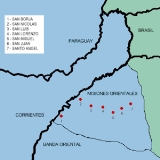
Misiones Orientales
Encyclopedia

South America
South America is a continent situated in the Western Hemisphere, mostly in the Southern Hemisphere, with a relatively small portion in the Northern Hemisphere. The continent is also considered a subcontinent of the Americas. It is bordered on the west by the Pacific Ocean and on the north and east...
, in present-day Rio Grande do Sul
Rio Grande do Sul
Rio Grande do Sul is the southernmost state in Brazil, and the state with the fifth highest Human Development Index in the country. In this state is located the southernmost city in the country, Chuí, on the border with Uruguay. In the region of Bento Gonçalves and Caxias do Sul, the largest wine...
, the southernmost State of Brazil
Brazil
Brazil , officially the Federative Republic of Brazil , is the largest country in South America. It is the world's fifth largest country, both by geographical area and by population with over 192 million people...
.
Together with present-day Misiones Province
Misiones Province
Misiones is one of the 23 provinces of Argentina, located in the northeastern corner of the country in the Mesopotamiсa region. It is surrounded by Paraguay to the northwest, Brazil to the north, east and south, and Corrientes Province of Argentina to the southwest.- History :The province was...
in Argentina and Misiones Department
Misiones Department
Misiones is a department located in the southern region of Paraguay. Its capital is San Juan Bautista. The eighth of Paraguay's 17 departments, it was created in 1906, then known as the San Ignacio Department, and was not given its present name until 1945...
in Paraguay it formed the Jesuit Reductions
Jesuit Reductions
A Jesuit Reduction was a type of settlement for indigenous people in Latin America created by the Jesuit Order during the 17th and 18th centuries. In general, the strategy of the Spanish Empire was to gather native populations into centers called Indian Reductions , in order to Christianize, tax,...
between 1609 and 1756, an almost fully independent territory created and ruled by the Catholic order of the Jesuits. It was famous for its resistance to enslavement and its egalitarian laws based on the Bible.
The King of Spain was the nominal ruler of these lands and in the Treaty of Madrid (1750)
Treaty of Madrid (1750)
The Spanish–Portuguese treaty of 1750 or Treaty of Madrid was a document signed by Ferdinand VI of Spain and John V of Portugal on January 13, 1750, concerning their empires and status of their territories in what is now Brazil....
he gave the eastern part of the Jesuit Reductions to Portugal. The seven Jesuit missions here were to be dismantled and relocated on the Spanish western side of the Uruguay River
Uruguay River
The Uruguay River is a river in South America. It flows from north to south and makes boundary with Brazil, Argentina, and Uruguay, separating some of the Argentine provinces of the Mesopotamia from the other two countries...
. The Guarani people living there refused, which led to the Guarani War
Guarani War
The Guarani War of 1756, also called the War of the Seven Reductions, took place between the Guaraní tribes of seven Jesuit Reductions and joint Spanish-Portuguese forces...
, won by Portugal and Spain.
The territory returned to Spain in 1777 in the First Treaty of San Ildefonso
First Treaty of San Ildefonso
The First Treaty of San Ildefonso was signed on October 1, 1777 between the Spanish Empire and the Portuguese Empire, shortly after the crowning of Mary I of Portugal and dismissal of Sebastião de Melo, Marquis of Pombal as de facto ruler of Portugal....
, but was definitively ceded to Portugal in the Treaty of Badajoz (1801)
Treaty of Badajoz (1801)
The Treaty of Badajoz was signed in Badajoz on 6 June 1801 between John VI of Portugal and representatives from the Spanish Empire. Based on the terms of the accord, Portugal agreed to cede Olivenza . Moreover, Portugal was required to close all ports to the British...
. It became part of Brazil
Brazil
Brazil , officially the Federative Republic of Brazil , is the largest country in South America. It is the world's fifth largest country, both by geographical area and by population with over 192 million people...
when this country gained its independence from Portugal in 1822.

